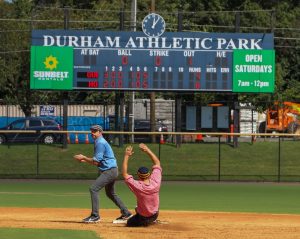Bird-watchers in North Carolina have gotten alarmed in the last few weeks as dead or dying birds began appearing in their backyards.
Biologists and people in the birdseed business say the deaths are not unusual, but that people are just more aware of them because of an increase in backyard bird feeders. They say homeowners can take a few simple steps to reduce the spread of the disease that has been killing the birds – and now has begun to sicken people.
The Centers for Disease Control and Prevention reported last week that 19 people in eight states had become ill with salmonella linked to songbirds. Eight have been hospitalized. No people have been sickened in North Carolina, but bird lovers have been urged to be cautious.
This kind of outbreak happens from time to time.
“Well first, let me tell you that salmonellosis is a common disease,” said Jeanne Mauney, the owner of Wild Birds Unlimited in Durham. “This is not a sudden outbreak. It’s not a COVID event. This is normal Pine Siskin disease.”
Falyn Owens, a wildlife biologist from the NC Wildlife Resources Commission, says the salmonellosis that infects birds is commonly known as salmonella and “it’s the reason why we always clean chicken before we cook it and eat it.”

Salmonella is a common pathogen passed between Pine Siskins, a small songbird that migrates to the South from Canada every three to four years. This year, North Carolina has seen an influx in these kinds of finches because Canada did not have a sufficient amount of seed to feed their flocks, causing what Mauney calls “an irruptive year.”
Owens suspects at least some of the increase of seeing dead or dying birds is due to people buying bird feeders during quarantine. People were searching for new ways to entertain themselves and are now concerned when they see sick, fluffy birds in their yards.
This also means that new bird feeder owners are unaware of the risks that run when interacting with wild animals, including the risk of pathogen transmission from bird to human.
One of the first steps to preventing the increase of dying birds is taking bird feeders down, although that can be an unpopular move within the bird-watching community. Feeders act as the perfect origin for a large outbreak.
“It’s basically a feeding trough where multiple animals are eating off of, back to back,” said Owens, “You can imagine if you had a whole cafeteria worth of people without washing it in between, there’s a risk of contamination.”
Pine Siskins are also social birds. They travel in big flocks to bird feeders where there are more opportunities to spread pathogens to each other.
After the initial break from bird feeders, Wild Birds Unlimited suggests more frequent cleaning with a bleach solution (1 part bleach, 9 parts water). While cleaning, it is necessary that people are extremely careful. Do not touch the feeders with your bare hands, and rinse your hands vigorously after cleaning. Transmission occurs when people touch their mouth after contact with the disease, whether directly with a bird, the seed, or a feeder.
Mauney said to clean feeders often. “While normally we tell you to clean it monthly, we are saying to do it weekly.”
Another option: plants instead of bird feeders.
Native plants like black-eyed susans and purple coneflowers can be found at most nurseries and are a natural food source for songbirds. While the upfront cost is greater than purchasing a bird feeder, native plants require less upkeep and there are no subsequent purchases of bird seed to continue attracting birds. These plants allow for bird-watchers to continue observing from their homes, but limit the spread of salmonellosis.
“I think the best, most ecological decision,” Owens said, “is to switch away from bird feeders at all and move to a more natural way of attracting birds into your yard to watch them and to enjoy them and give them food and shelter is by providing food to them through native plants.”




